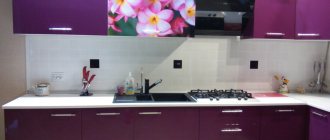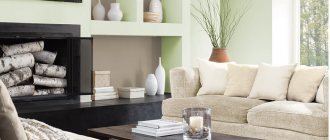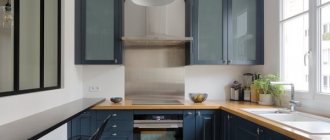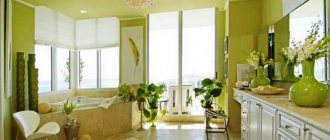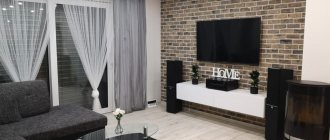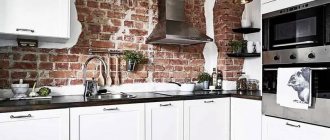If you think that brick can only be used for exterior decoration, you are mistaken. Designers often use this material when decorating various types of premises. However, most often brick walls are decorated in the kitchen - a reliable, durable and beautiful material has excellent performance properties and adds coziness to the room.
The use of brick makes any kitchen original and cozy
Read our article about how to properly decorate a kitchen using brick, what its features are and how best to use brick elements in the interior.
Advantages and disadvantages of brick in the kitchen
Like any finishing material, brick has both its pros and cons. Moreover, both of them can be considered quite significant.
A brick wall is a beautiful, but rather difficult move
It should be noted that brickwork in general is a rather unique material - on the one hand, it looks very stylish, on the other hand, it must be used carefully in the interior so as not to get the effect of an unrenovated room.
So, let's look at the list of advantages of brick in the interior:
- First of all, these are its operational properties. Brick is a reliable and durable material that can withstand difficult conditions in the kitchen. Constant moisture, temperature changes, greasy drops - all this will not cause significant damage to your wall. Therefore, brick is often used, among other things, for finishing the apron.
- The brick wall looks very unusual and attracts attention. This finish looks stylish and beautiful, if, of course, you managed to correctly use it in the interior.
- This is one of the most economical ways to decorate a wall. You will not need additional finishing, and the brick itself is not too expensive.
- The material has excellent heat and sound insulation properties, so there is no need to lay a separate insulating layer.
- In fact, brick is a universal material . It is used not only for wall decoration, but also for floors, ceilings, decorating a kitchen island or bar counter, and an apron. All this allows you to create an original and holistic interior.
- If you wish, you can do without the help of builders - laying brickwork in one row is not difficult with your own hands , even if you have never done repairs before.
- Brickwork is a great way to zoning space . By decorating a wall or part of it in this way, you can separate the kitchen area from the dining room and allocate a specific place in the kitchen.
- Brick goes well with all other materials. Wallpaper, tiles, decorative plaster - you are practically unlimited in finishing combinations.
As you can see, brick is an inexpensive material that can be widely used in the interior of the kitchen. In addition, it has excellent performance properties.
What about the downsides? Let's see what you need to be careful about when working with brick:
- If after the list of advantages you have a desire to decorate all the walls with brickwork, you will have to abandon it. Brick should be used sparingly in the interior, even if you are a fan of the urban loft. Otherwise, instead of a beautiful and cozy kitchen, you risk getting a strange room that evokes associations with an abandoned construction site.
- Despite its strength, brick requires very careful maintenance. It has a porous, heterogeneous structure. Due to this, grease and dirt accumulate in the seams. This means that you will have to wipe such a wall regularly - otherwise you risk quickly ruining the appearance of the wall.
- If you choose red brick to decorate the room, you won’t be able to save on lighting - you will need a lot of artificial light . Terracotta brick practically does not reflect light fluxes, so you will need many times more lamps than when using other materials.
- As already mentioned, you should handle bricks with care. Especially if you decide to choose dark tones of the finishing material, go a little overboard, and the room will seem gloomy and unkempt.
As you can see, the disadvantages can be considered quite conditional - if you show common sense, correctly design the lighting system and do not forget about caring for the brickwork, such a wall will serve you for a long time without losing its appearance and performance properties.
If there is a lot of brick in the interior, you need to work with it very carefully. With the right approach, brick helps create a very beautiful interior.
Combine brick with less capricious interiors so as not to overload the space
How to properly use brick in the interior? We hope the advice of our designers will help you with this!
Types of bricks
Brick in kitchen design can be different. Natural coverage works best, but it is not always appropriate. It is not necessary to buy natural material if there is no money or space does not allow. It can be replaced with an imitation, and done with your own hands.
Natural brick
A brick summer kitchen should be made primarily from natural materials. For example, natural masonry. It is massive, durable and is not afraid of temperature changes and humidity. But the cost of natural bricks, especially unusual shades, is higher than artificial materials.
Facing brick
It is made from several materials: clinker, ceramics, gypsum, porcelain stoneware. Outwardly it is very similar to natural, but inferior to it in strength. Easy to install.
Tip 1. Study the rough finishing of the kitchen
Perhaps you are lucky and live in a house with brick walls. In this case, we recommend that you do not invent unnecessary problems for yourself - it is quite possible that you will not need to additionally lay decorative bricks.
Sometimes it is enough to remove the finishing trim to get a beautiful brick wall
It will probably be enough just to carefully clean the wall - sand the seams, remove all dirt.
This way you will get a great brick wall without breaking the bank. However, this is not always possible. If you are unlucky with a brick wall, the next point is for you.
The main thing is to balance the interior well. This kitchen looks very original
How to care for decorative brickwork
After repairs, you should not relax, since the decorative material will require regular washing and cleaning procedures. Owners need to regularly wash the walls with a damp cloth to remove food residues that fall on the coating during cooking, traces of grease and dust. If the masonry is located above the stove, then it is best to wipe it after each cooking. You can also carry out dry cleaning using a broom or brush to remove dust.
The best option is to use a spray bottle. You need to fill it with water, spray it on the surface of the wall, wait until the dirt flows down and remove it with a dry cloth. It is best to additionally treat the surface and apron with protective varnishes. Housewives should also avoid frequent drafts, which can damage the decorative brick wall.
A kitchen with a brick wall is an excellent option for such styles as loft, country, and gothic. Since natural brick is quite expensive, owners can use artificial brick as an alternative. It is practically no different in appearance. At the same time, the material is considered safe, environmentally friendly and durable. It can be used in various design directions with all sorts of color schemes.
Tip 2. Decide on materials
At first glance, this advice sounds strange - a brick is a brick. What is to be determined here? However, in fact, the issue is deeper than it might seem at first glance.
A wide variety of materials can be used as bricks in the kitchen.
Most often, special decorative bricks or its imitation are used for the kitchen. Variations are possible here. We recommend that you familiarize yourself with the list of materials to make the right choice.
First of all, we do not recommend using wallpaper with a brick print. Yes, such a coating can be distinguished by high quality printing and at first glance be very reliable. However, the absence of a characteristic structure will completely kill the special charm that is inherent in brick walls.
One of the most popular options is ceramic tiles that imitate brick. Firstly, it is very easy to install. Secondly, the appearance, thanks to the volumetric texture, fully matches the brickwork. In addition, due to the special glaze, such tiles are ideal for finishing an apron - cleaning such a coating is much easier than natural porous brick.
Sand-lime bricks are also good for kitchens. The properties of the material provide them with increased resistance to moisture, steam and temperature changes. Plus, they look very beautiful and authentic. They are produced in various colors. In addition, the coating can be painted - a great way to quickly update your kitchen interior.
Very often, gypsum tiles are used to decorate kitchens. They can be of different shapes and sizes, so using them is easy to recreate any type of brickwork.
Gypsum can be used in different areas of the kitchen
A nice bonus is the thickness of the gypsum blocks. It is only five millimeters, so gypsum is ideal for small kitchens. The color scheme is also pleasing - from the usual white and terracotta to complex, sometimes unexpected colors.
An interesting solution is the use of MDF panels that imitate brickwork. This is perhaps the fastest way to decorate your kitchen like a brick. Due to the fact that the panels are quite large in size, you can lay the entire wall in a matter of hours. In addition, it is almost impossible to visually distinguish a fake from real brickwork. However, remember that in terms of performance properties, brick significantly exceeds the characteristics of MDF panels.
Even this one. the panel can be installed in a matter of hours
How to replace natural material?
If the house originally had such a wall, then there will be even less hassle. You just need to clean it of putty, plaster and construction dust, cover it with varnish or paint to give additional protective properties and to comply with hygienic and sanitary standards.
In other cases, you can use decorative or brick-like facing tiles, which well imitate their real counterpart. The most popular are brick tiles based on gypsum and cement mixtures.
By design, you can choose any color: from bright brown to white and intermediate options with many shades to suit any interior. The size of the tiles is similar to real brick. And according to the structure, you can choose chipped, artificially aged, with perfectly smooth edges.
Another material for imitation is ceramic tiles. Often found in apron designs. Will fit into Provence, Scandinavian, art deco. Can be glossy or matte.
In stores you can find wallpaper that imitates masonry. There are even embossed, voluminous options.
Although wallpapering is easier and faster than laying tiles, the end result will not have the same noble effect compared to the same decorative tiles. In terms of money, the latter will be cheaper. The advantage is that if you get tired of the design, the wallpaper can be quickly removed. In the case of tiles, the wall will need to be re-prepared for a different material: leveled, puttied, etc.
This may also be interesting: Liquid wallpaper in the kitchen: all the pros and cons.
Tip 3. Decide on the texture
The brick does not have to be porous, like the one we are used to seeing in exterior decoration. Now the blocks are treated with a special glaze, which allows you to give the most varied appearance to the material.
Bricks can be very different
For example, you can use classic matte bricks - they are great for creating traditional interiors.
The usual matte brick
However, glossy glazed bricks also look very interesting. In addition, due to their reflective properties, they visually make a small kitchen larger. A significant bonus, especially when you consider that the brick itself conceals the space, making it smaller and cramped.
Interesting and attractive solution
A fashionable solution for interiors in the industrial loft style is chipped brick. The blocks appear a little broken, their edges are torn, and their texture is uneven. Due to this, the coating seems very voluminous and original. True, you need to work with such material very carefully, otherwise the kitchen will take on a sloppy, abandoned appearance.
Rough finishes should be compensated with elegant furniture
Review of manufacturers
Among domestic manufacturers of brick wallpaper, the first line is occupied. It was formed in the mid-90s of the last century. During this period, the company became a leader not only in the domestic market, but also abroad.
The specialists of this company daily analyze the building materials market and fashion trends, introduce and create new products in this segment. Most of the products are exclusive wallpapers, created by the world's best minds. The product quality is at the highest level, even in the economy segment.
Russia is represented in the ranking by one more. This manufacturer has ten years of experience. It produces its products from environmentally friendly raw materials and using European equipment. Excellent combination of price and quality.
The world leaders in this area are companies from the United States of America. Such high indicators are achieved not only due to high technologies and accumulated experience, but also due to the cooperation of this country with manufacturers from all over the world.
American brands are not afraid to experiment and annually release dozens of new collections designed both for domestic buyers and for export.
Among American manufacturers we can highlight the companies Wallquest, Fresco, Living Style. In the domestic market, wallpapers that imitate brickwork from Chesapeake, Nextwall and Tiffany Design are widely popular.
Analyzing customer reviews, we can state that they also highlight English manufacturers. First of all, due to environmentally friendly components, and secondly, for its commitment to the classic style. Although it is worth noting the fact that the UK is also developing modern collections designed for the hi-tech style. In Russian construction stores you can find wallpaper from Chelsea Designs, Prestigious Textiles and Sanderson.
Belgian companies - Calcuta, Grandeco and Omexco made history thanks to the creation of seamless wallpaper. This became possible after “crossing” paper, non-woven fabric and textile materials. By the way, their vinyl wallpaper was the first to be painted over the entire surface.
Germany has been a European leader in both the electronics and construction markets for decades. Thanks to established technologies and design ideas, companies such as Decor Deluxe, Architects Paper and P + S International take their place in the sun.
But manufacturers from the Netherlands have gone the furthest in terms of realism. They succeeded in recreating three-dimensional pictures and optimistic scenes. This contributed to the fact that they were included in the ranking of manufacturers with good performance. Manufacturers Eijffinger, Esta Home and BN International work only with modern components and keep up with the times.
Italian wallpaper is the standard of quality. Every second manufacturer from this country produces collections in classic, retro and loft styles. Their collections also include brick-like wallpaper. Non-woven and vinyl wallpapers are produced by the companies Decori Decori, Sergio Rossellini, Emiliana Parati. But in Russia the most famous brands are Roberto Cavalli and Limonta.
The Premium segment includes French companies – Casagedo, Casamance and Camengo. Unfortunately, their cost is not affordable for everyone, so they are not represented on the domestic market. But they are available upon individual order.
From time immemorial, Swedish wallpaper has been the most durable. They can easily withstand mechanical damage, have an unexpected design and are suitable for any room. The emphasis on safety is placed by MR Perswall and Borastapeter.
When choosing combined options for brickwork, wallpaper with silk-screen printing has proven itself well. The birthplace of wallpaper is the People's Republic of China. A few centuries ago, the Chinese were the first to use bamboo fabrics for interior decoration. Such wallpapers have a long service life. Among the Chinese manufacturers, Artshow and Loren can be noted.
Korean and Japanese companies produce fifteen-meter rolls to reduce seams. Companies such as LG, Oriental Coat, Fuji Kogua are rapidly conquering the market.
Among the countries of the former Soviet Union, manufacturers from Ukraine and Belarus occupy a worthy place in the domestic building materials market. They absorbed all the best that was in Soviet technologies and brought new ones from Europe.
Tip 4. Find the right color scheme
There is an opinion that brick walls can only be red, terracotta or white. This is fundamentally wrong. Modern possibilities make it possible to give brickwork any color - and we’re not even talking about painting, which gives you the chance to change the interior of the kitchen at least every month.
You can find brick in almost any color
In addition to classic solutions, you can choose almost any color. Brickwork in unexpected tones looks very interesting - blue, pistachio, green, straw.
We recommend choosing textured shades - interspersed with minerals and various decorative additives. This will make your wall seem more original and voluminous.
Bricks painted using the ombre technique look interesting
In addition, you can experiment with color combinations and even lay out a unique brick mosaic. However, keep in mind that such a solution requires quite a lot of financial costs and effort - nevertheless, decorating an ordinary brick wall is much easier. But the result will be much more original.
Take the time to find an interesting type of brick
Design ideas
Imitation of masonry in combination with wood looks harmonious, stylish and allows you to achieve a unique, cozy and warm atmosphere in the kitchen. A wooden kitchen set will especially stand out against the background of a red-brown brick finish. The natural color scheme of the brick highlights the natural wood tone, while the natural texture of wood smoothes out the roughness of the brick finish.
An unusual solution is the use of facing material with an aging effect. A plane lined with glass or mirror bricks looks no less original when decorating a kitchen.
The photo shows a brick wall in the kitchen combined with a set of natural wood.
For a kitchen interior in an antique style, it is appropriate to use classic masonry to decorate a modern stove. Decorative bricks are used to lay out the portal, as well as a false panel that covers the hood and create a structure similar to a fireplace chimney.
The photo shows a kitchen design with photo wallpaper imitation aged brick.
Tip 5. Take care of additional processing
If you want to place a brick directly next to the oven or use it to decorate an apron, we recommend that you additionally cover it with a thin layer of scraping varnish. This will greatly simplify cleaning - dirt and grease will not penetrate the pores of the material, which means the coating will last you longer.
If you want to use brick near the work surface, it is better to further process it
If you are afraid that such processing will spoil the texture of the brick, do not worry. Modern materials can be applied in one layer, so that they form a thin protective film, not too noticeable at first glance.
Modern means make processing invisible
In addition, no one forces you to choose a flashy glossy finish - you can easily use matte varnish.
Wallpaper
If you doubt whether this interior solution will suit you, you can “rehearse” it by gluing wallpaper with a brick pattern.
Now manufacturers offer a huge selection of such wallpapers:
- From a simple schematic image to a three-dimensional and textured one, when from a distance you won’t understand that this is wallpaper in front of you.
- Perfect as a decorative option in the eating area or where storage is organized.
- The main thing is to avoid contact with water and fire!
Tile
There is a huge selection of tiles that imitate masonry. These can be luxurious cuts of natural vintage brick, or budget gypsum tiles. It will turn out quite natural and relief. This option is suitable for both decoration and practical purposes, because the materials are washable, heat- and wear-resistant.
Gypsum plaster
An excellent and very budget solution is to create a brick wall with your own hands using gypsum plaster. A master can help you with this, but if you decide to do it yourself, you will get a lot of positive emotions and valuable experience. We'll tell you further how to make a wall from such plaster with your own hands!
Finally, if you like the graphic effect that brick creates on a wall, but don't want to use any of the materials listed, tile may be your option.
A very common model now is the “white boar” - an elongated tile in the shape of a rectangle. It will appeal to those who want to decorate an apron.
Tip 6. Try painting the brick to match the walls
Do you have a small kitchen that you want to make more comfortable? A single-color covering for all walls and brick in the dining room or work area is a very suitable solution. To make the room even prettier, we recommend sticking to one color scheme.
Nice monochromatic solution
This way the brickwork will stand out only due to its volumetric texture. This move will add coziness to the room, but the brick will not attract attention - for a small kitchen it is better not to use too flashy techniques.
This combination looks very impressive
How to choose brick tiles
When you don’t have time to lay natural tiles, you can choose imitation. Things to consider:
- Room area, dimensions.
- Room style.
- Features of the climate.
- Your wishes.
- Budget.
A ready-made ceramic brick kitchen apron will cost more than a plastic panel. But a high price is not always an indicator that this kitchen material will be better than a more affordable one.
Tip 7. Organize your lighting correctly
Brick does not have very good reflective properties. Therefore, we recommend placing a brick wall opposite the window - so natural light will smooth out this effect.
A kitchen with brick requires a lot of light
In addition, it is very important to properly highlight a prominent wall. Use several lamps at once - this will help highlight the beauty of the brick.
Lamps must fit into the interior and complement it
Additional lighting won't hurt
Imitation
Many owners nowadays refuse to install natural or decorative bricks on the walls of their homes. This is due to the fact that today there are a large number of alternatives that not only have an affordable price, but are also easier to install. Let's get to know them better.
Clinker tiles
Beautiful clinker tiles made to match colored or snow-white brickwork are very popular among modern consumers.
The main advantage of this design solution is that it takes up a minimum of free space in the room, and this is very important if your home does not have a large area
Today in specialized stores you can find a huge number of different clinker tiles, having different shapes, sizes and colors. The base in this case is finished according to the principle of standard tile material, observing neat seams. Such options are ideal for the kitchen, as they are not afraid of either dampness or exposure to high temperatures.
Texture wallpaper
Attractive textured wallpapers that imitate snow-white brickwork are in great demand. Such products are so plausible that they do not immediately reveal themselves, and many people confuse them with real white bricks. The difference can only be noticed upon closer inspection.
Brick textured wallpaper is an ideal solution if you are arranging a small home where there is simply no room for natural or decorative bricks. In spacious rooms, these canvases also look organic.
Textured putty
No less popular is the imitation of a brick wall, created using a textured putty mixture. To organize such a spectacular decoration, you need to stock up on high-quality starting putty, as well as suitable tile adhesive. These components are mixed in a 50:50 ratio.
Tip 8. Caring for untreated brick is an important task.
If you decide not to glaze or paint your brickwork, you will have to take very good care of it in your kitchen. This is especially true for bricks laid in the area of the slab or apron.
This apron looks beautiful, but requires special care
Any greasy stain is dangerous - it can be absorbed into the porous structure and noticeably change the color of the material.
Therefore, it would be the best solution to keep some kind of grease solvent in the kitchen - as soon as the stain gets on the surface, carefully remove it.
It is also important to promptly remove water that gets on the brick. It tolerates air humidity and steam well, but prolonged contact with liquid may cause whitish stains on the material.
Untreated bricks need to be wiped down regularly
Color palette
Brickwork in the kitchen is distinguished by a variety of colors. Each shade is appropriate in a specific style and is selected in accordance with a specific room and interior design.
White brick in the kitchen interior
White brick is common in the kitchen. It visually makes the space lighter, the room wider, more spacious. You can lay the entire wall or just the apron area - it all depends on the size of the room and the choice of material.
Red brick
Red brick masonry in a kitchen is usually placed above the countertop. If the house is brick, you can leave one small wall, cleaning it and covering it with protective varnish.
Gray brick
Design solutions with gray brick are often embodied in loft kitchens. Other colors used for interior decoration when choosing cladding of this shade: white, black, dark brown, silver.
Black brick
Wall cladding with black brick is appropriate only in moderation - in the apron area, behind the kitchen unit, behind the TV, refrigerator and other appliances. This option is only suitable for a room with natural light and large windows: the black color and rough surface of the brickwork will “take away” the light. Therefore, darkened kitchens with black brickwork will be quite gloomy.
Aged brick
A kitchen-living room with natural aged brick in a classic, modern or loft style will look most advantageous. This option is appropriate when the house/apartment has a finished brick wall, for example, the load-bearing structure of a building. Repair costs here will be minimal, and the surface itself will become one of the main accents of the interior.
Tip 9. Decide on a style
Why did we put it at the very end of the article? We have already mentioned that with the right approach, brickwork can fit into almost any interior.
Classic set with brick wall
However, there are still styles where the use of brick is much more preferable than others.
First of all, this is, of course, a loft. Along with concrete, brickwork is recommended for use in such interiors.
A great example of an urban loft
Brickwork in such styles as country and Provence has proven itself well. Here it is better to choose not too large blocks and light shades.
Cozy country kitchen
White brick is practically a must-have for the Scandinavian style. This wall fits perfectly into the concept and makes the interior light and spacious.
A Scandinavian kitchen cannot be imagined without white brick.
For other types of interiors, brick can be used, but this should be done with caution. Choose colors that suit the design concept of the style, make sure that this material does not conflict with others. It is difficult to imagine a textured “broken” brick wall in the Victorian style. But elegant bronze masonry is quite appropriate there.
American style kitchen with brick wall
Use common sense and stylistic rules - and everything will work out.
General design rules
Before we look at examples of successful design, we need to immediately identify several general points. In finishing it is important:
- choose the right brick color.
Light colors are for a small kitchen, dark colors are for a well-lit kitchen.
The color also depends very much on the style. In a Norman or Scandinavian interior, white and gray are more appropriate. But in a loft or pop art, a brown color scheme would look good;
- choose the right wall.
You need to make masonry or its imitation on the wall on which more light falls.
Since such an element is an accent, it is necessary to highlight it favorably. In the shadows, such a design looks gloomy and will not have the desired effect;
- decorate only one wall.
Even two such walls in one room are too much. You may have come across an example of a successful interior, for example, with the design of two adjacent or opposite sides, but most likely it was a spacious room, well lit, with panoramic windows. In most apartments, the space does not allow this to be repeated. But you can focus on one wall even in a small kitchen in a Khrushchev-era building (6 - 7 sq.m.).
Kitchen in Khrushchev with brickwork. Light colors visually add space and seem to lighten the whole environment.
Brick in the kitchen interior: 30 real photo examples
To clearly show how advantageous a material brick can be, we have compiled a selection of photographs. Brickwork in kitchens in various styles - we are sure you will like it!
Decor with a brick wall
Accessories are selected depending on the style.
For example, in romantic Provence, vintage items, forged flower stands, clay pots, and aged wood go well with brick.
The pop art interior will be complemented by bright posters, paintings and textiles in rich colors.
In the loft style, in combination with such a finish, candlesticks, interesting lamps, wooden photo frames, forged figurines, and rough wooden shelves will look great.
Antique clocks, mirrors, artwork and posters also work well with brick finishes.
Decorative wall
If you have a place in the kitchen where various decorative items are collected, decorate it with brick. This solution looks good in country style. Everything looks appropriate and harmonious. Make the tabletop in this place from wood so that natural materials are nearby.
Photo: estabul.com
What types of brick wallpaper are best for the kitchen?
Types of trellises for brick
You can choose many options for trellises for brickwork for your kitchen interior. They differ not only in color, but also in the quality of the material, the number of stones and their expression against the general background. At the same time, the price of the finished version also plays an important role. There are several of the most popular types of wallpaper for brick kitchens:
- Vinyl - perfectly imitate brickwork and all its roughness. Vinyl protects walls well from external influences, be it abrasions or stains. It successfully tolerates moisture and dampness, therefore it is a universal material. This type of trellis is impervious to sudden temperature changes, which means it is well suited for kitchens.
- Paper - the cheapest of all types. Unlike others, paper wallpapers are made from environmentally friendly materials, so they do not pose a threat to the health of household members. Small protrusions in the form of brickwork will create a unique atmosphere in the room, and this, along with other advantages of paper wallpaper, makes their choice a priority.
- Non-woven ones are far from the best type, but this option is acceptable for the kitchen. Its main advantages: good adhesiveness, pliability, durability and washability. The non-woven covering can create a natural look for the masonry and is easy to remove.
An advantage when choosing non-woven wallpaper is its price, since in comparison with vinyl they are quite cheap.
Option for children's
A controversial solution is brick finishing in the room where the children are located. The rough appearance looks somewhat harsh for the tender age of babies. But for older children, whose imagination is already so developed that they prefer the style of castles or living conditions in catacombs, such a discovery will be interesting.
The coating is both safe and pleasant to the touch.
The informal thinking of the younger generation makes such unusual decoration especially attractive. This unique canvas will take on posters, paintings with abstractions and all kinds of photographs of idols.
Photo gallery
For inspiration, look at photos of real interior design:
How do you like the article?
